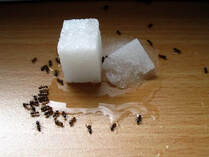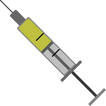|
Scientists and physicians have been documenting the condition now known as diabetes mellitus for thousands of years. The name diabetes comes from the Greek word, meaning to siphon, and mellitus is a Latin word meaning sweet. The name fits because diabetes is a condition which results in an excess of sugar in blood, as well as in the urine.  Diabetes symptoms were first mentioned in 1552 BCE, when frequent urination and emaciation were documented. Ancient healers also noted that ants seemed to be attracted to the urine of people who had this disease. By the 18th century physicians understood that dietary changes and activity could help patients manage their diabetes. In 1841 a chemical test was developed which could detect the presence of sugar in the urine.  Dietary recommendations for managing diabetes led the way for fad diets of the early 1900s such as the "oat-cure," "potato therapy," and the "starvation diet". Today, diabetes educators still use the principles of regular exercise and proper diet when teaching patients about lifestyle changes for management of the disease. The First Insulin Injection A starvation diet had brought 14-year-old Leonard Thompson’s weight to 65 pounds. Even living on a diet of less than 500 calories a day (boys his age should consume 2000-3000) did not adequately lower his sustained hyperglycemia. In January 1922 he was in the hospital in a diabetic coma, with severely high blood glucose.  The sparse diet had been an attempt to prolong Leonard’s life by a few years. However, it would not save his body from the damage caused by sustained hyperglycemia. It was under these circumstances that his father, desperate to save his son’s life, agreed to an experimental treatment. He allowed doctors to inject his son with a “pancreatic extract”.  Although Leonard’s blood sugars went down a little following the injection, there was not a lot of change. The doctors were undeterred. Biochemist Dr James Collip, who had been working with Dr Frederick Banting and medical student Charles Best on the diabetes treatment, refined the extract and daily injections of insulin started on January 23rd.  Leonard’s condition improved. His blood sugar dropped to normal levels. Leonard Thompson went on live another 13 years with daily injections of insulin. He did, however, later die of broncho-pneumonia and complications from diabetes. What Causes Diabetes?  Normally, food we eat gets digested, or broken down, into various nutrients. Foods that contain carbohydrates (like bread and pasta) are broken down into the sugar, glucose. Glucose provides the energy cells, tissues, and organs need to properly function.  Glucose in the bloodstream needs help to get into the body’s cells. Insulin, a hormone, is released by the pancreas into the bloodstream. The insulin binds to receptors on the surface of cells, allowing glucose to move through the cells’ membranes.  If the body doesn’t function properly, and the pancreas either doesn’t make insulin, doesn’t make enough insulin, or the body’s cells don’t respond properly to the insulin, sugar builds up in the bloodstream. This serious condition, called diabetes, is when the body’s cells can’t take in glucose for energy.  So, its not sugar itself that causes diabetes. Eating foods high in sugar content can lead to weight gain, which is a risk factor for developing diabetes. Eating more sugar than is recommended leads to all kinds of health harms in addition to weight gain. The American Heart Association recommends consuming no more than six teaspoons a day (25 grams) for women and nine teaspoons (36 grams) for men. Why Too Much Blood Sugar is a Problem If blood glucose levels remain high over a long period of time, the body’s organs can be seriously damaged. Blood vessels, located throughout the body, surround the cells, providing a transfer of oxygen, nutrients, and other substances, using blood as the exchange vehicle. Put simply, diabetes doesn’t allow glucose (the body’s fuel) to get into cells and it damages blood vessels in and near organs, tissues, and nerves.  If organs, tissues, and nerves, aren’t properly nourished, they fail. Examples of organ, nerve, or tissue failure includes the narrowing or blocking of the heart’s arteries, kidneys being unable to filter waste products out of blood, blood vessels in eye’s retinas breaking down (leading to blindness), and nerves in the feet not getting nourishment due to inadequate blood flow. Persistent hyperglycemia may also damage blood vessels involved in hearing and hair growth.  Poor circulation, a consequence of uncontrolled diabetes, means oxygen and nutrients aren’t delivered to cells and the body is more prone to the development of cuts and sores that lead to infections that can’t fully heal. Areas of the body that are farthest away from the heart, like toes, feet, legs, and fingers are more likely to experience the effects of poor blood flow and may need to be amputated if infection develops and healing is poor.  Complications of diabetes include life-threatening conditions like coronary artery disease, stroke, high blood pressure, high cholesterol, and atherosclerosis. Persistent hyperglycemia can cause neuropathy that manifests as numbing and tingling in the extremities. Diabetes can also lead to kidney failure, skin infections, and dental problems, among other health issues. Diabetes Can Be Managed: Healthy Lifestyle, Blood Glucose Monitoring, Medication Today, diabetes is diagnosed and managed by checking blood glucose levels. Blood glucose level can be checked with an 8-hour fasting plasma glucose test, a random plasma glucose test, or an A1c (glycated hemoglobin) test, which provides an average blood glucose level over the past 2-3 months. An oral glucose tolerance test may also be administered both before and two hours after ingesting a sweet drink to determine how the body processes sugar. The results of normal and diabetic conditions are displayed on the table below. (The blood glucose levels are shown both in milligrams per deciliter (mg/dL) and millimoles per liter (mmol/L). Both units give a measurement of the concentration of glucose in the blood. The unit for measuring glucose in blood in the US is mg/dL. It gives the concentration of glucose by the ratio of its weight to blood volume. The international standard for measuring the concentration of glucose in blood is mmol/L. It gives the number of molecules of glucose within the 1 liter of blood.)  Having a blood glucose level that is below 70 mg/dL is called hypoglycemia. At that point, the body needs sugar. Symptoms of hypoglycemia include weakness, shaking, sweating, fast heartbeat, dizziness, hunger, confusion, pale skin, mouth or tongue numbness, irritability, nervousness, restless sleep, blurred vision, headaches, and seizures.  Having a blood glucose level greater than 125 mg/dL while fasting or a level greater than 180 mg/dL 1-2 hours after eating is called hyperglycemia. Symptoms of hyperglycemia include increased thirst and/or hunger, frequent urination, headache, fatigue, and blurred vision. Diabetes is best managed by keeping blood glucose levels within a normal range. This is done by eating the proper proportions of nutritious foods, exercising at least 30 minutes daily, and, if prescribed, taking medication.  The recommended meal plan for diabetics, as well as general good health, is to follow a Mediterranean or DASH (Dietary Approach to Stop Hypertension) diet. The foundation of the eating plan is plant-based foods, such as whole grains, vegetables, legumes, fruits, nuts, and seeds. Olive oil is the main source of added fat. Seafood, dairy, and poultry are included in moderation. Red meat and sweets are eaten only occasionally. Types of Diabetes Mellitus  Prediabetes is when blood sugar is higher than it should be but not high enough for a diagnosis of diabetes. Prediabetes increases the likelihood of getting type 2 diabetes and heart disease. Exercising more and losing extra pounds, even as little as 5% to 7% of your body weight, can lower those risks.  Type 1 diabetes is also called insulin-dependent diabetes (formerly called juvenile-onset diabetes because it often begins in childhood) is an autoimmune condition. It happens when the body attacks the pancreas with antibodies. The organ is damaged and doesn't make insulin. This could happen for genetic reasons or because of problems with cells in the pancreas that make insulin.  Type 2 diabetes is the more common form of diabetes, which about 90% of people with the condition have. Type 2 used to be called non-insulin-dependent or adult-onset diabetes, but it is now more common in children due to their increased weight. In type 2, the pancreas usually creates some insulin, but its either inadequate or the body doesn’t use it as it should. Insulin resistance, when cells don’t respond to insulin, usually happens in fat, liver, and muscle cells. Although milder than type 1, type 2 can still cause major health complications, as well as raise the risk of heart disease and stroke.  People who are more than 20% over their target body weight for their height have a higher risk of type 2 diabetes and the health problems that can follow. Obesity often causes insulin resistance, so the pancreas must work harder to make more insulin. The insulin that the pancreas produces is still not enough to keep blood sugar levels where they should be.  Gestational diabetes can develop in some women during their pregnancy. Although it may go away after pregnancy, these women are at a higher risk of developing Type 2 diabetes later on in life.  During pregnancy, the body makes more hormones and goes through other changes, such as weight gain. These changes cause the body’s cells to use insulin less effectively, a condition called insulin resistance. Insulin resistance increases the body’s need for insulin. All pregnant women have some insulin resistance during late pregnancy. However, some women have insulin resistance even before they get pregnant. They start pregnancy with an increased need for insulin and are more likely to have gestational diabetes.  Gestational Diabetes should be controlled because the mother’s blood sugars travel through their placenta to the baby. Controlling blood sugar helps to protect the baby's growth and development. Gestational diabetes is more of a risk for the baby than the mother. A baby might have unusual weight gain before birth, trouble breathing at birth, or a higher risk of obesity and diabetes later in life. The mother might need a cesarean section because of an overly large baby, or they might have damage to their heart, kidney, nerves, and eyes. In 1-5% of people who have diabetes, other conditions might be the cause. These include diseases of the pancreas, certain surgeries and medications, and infections. In these cases, blood sugar levels are often monitored. Other Kinds of Diabetes Diabetes insipidus is a rare condition that causes the body to make a lot of urine that is "insipid," or colorless and odorless. There are several different types of diabetes insipidus that may result from damage to the hypothalamus or pituitary gland, problems with the urinary tract or kidneys, or how the body responds its water balancing hormone. Like diabetes mellitus, the symptoms of diabetes insipidus include thirst and frequent urination. However, with diabetes insipidus, the condition results from problems in the way the body balances its fluids. Other rare kinds of diabetes include monogenic diabetes syndromes, which are inherited, cystic fibrosis-related diabetes, and chemical-induced diabetes, which can happen after certain medical treatments. The cause of diabetes, regardless of the kind, is having too much glucose circulating in the bloodstream. However, the reason why blood glucose levels are high differs depending on the kind of diabetes. How Insulin of Today is Used to Treat Diabetes Mellitus?  Since Leonard Thompson was treated with insulin in 1922, the drug has been improved. Leonard was injected with “a reasonably pure formula” from the pancreases of cattle from slaughterhouses. Once news of his successful treatment spread, large-scale production of insulin began. Soon there was enough insulin to supply all North America. In the decades that followed, manufacturers developed a variety of slower-acting insulins.  Insulin from cattle and pigs was used for many years, but it caused allergic reactions in many patients. The first genetically engineered, synthetic “human” insulin was produced in 1978 using E. coli bacteria to produce the insulin. The first commercially available biosynthetic human insulin was sold in 1982.  Insulin now comes in many forms, from regular human insulin identical to what the body produces on its own, to ultra-rapid and ultra-long-acting insulins. People with diabetes can now choose from a variety of formulas and ways to take their insulin based on their personal needs and lifestyles. Insulin is not a cure for diabetes, but it is a life saver. Other Diabetes Mellitus Treatments There is a demand for diabetes treatment. About 10% of people in the US have the condition. The number of people who are diagnosed with diabetes increases with age. More than 26% of adults aged 65 and older have diabetes.  A person with type 1, insulin-dependent diabetes, who also has severe kidney disease, may be considered for a pancreas (or pancreatic islet -- the cells that make insulin) and kidney transplant. If their surgery is successful, their body will be able to produce insulin again. This is not a routine treatment. Getting an organ transplant requires taking immune-suppressing drugs for the rest of one’s life.  Immunotherapy for Type 1 diabetes is a treatment that is being researched. Since Type 1 is an immune system disease, immunotherapy may one day be able to turn off the parts of the immune system that cause the Type 1 disease.  Bariatric surgery is an option for Type 2 diabetics who have a body mass index over 35. Bariatric surgery is a term that refers to surgical procedures that assist in weight loss by making changes to the digestive system. There are several types of surgical procedures that may be performed to assist people in losing weight. Improved blood glucose levels are seen in people who have lost a significant amount of weight, but the procedures carry risks. Other Lifestyle Changes In addition to following a Mediterranean diet, monitoring blood glucose, and taking medication, if it has been prescribed, other healthful choices can help manage diabetes. Learning relaxation techniques such as deep breathing exercises, meditation, and yoga can help manage stress. Alcohol intake should be limited to 1-2 alcoholic beverages per day. Getting an adequate amount of sleep (typically 7 to 9 hours) is important. And any tobacco use, such as cigarettes smoking, should be stopped. A Sweet Experiment Glucose, a simple sugar, is the body’s main energy source. It is the simplest form of carbohydrate, known as a monosaccharide. Glucose is also known as blood sugar, and it plays an important role in the body’s function.  A healthy body’s processing of glucose happens when food is ingested. When we eat, our body immediately starts breaking down the glucose with enzymes and help from our pancreas. The pancreas produces insulin and other hormones to handle the rising blood sugar levels. Too much sugar is unhealthy, but in the correct amounts, it is necessary for energy.  You can use this investigation with your class to examine the glucose levels in different types of fruit. This can help students determine which fruits and what quantities of them they should include in their diets. You only need a few materials. They are a variety of fresh fruits, a variety of fruit juices (examples: watermelon, orange, grapefruit, pineapple, apple, blueberry strawberry, blackberry, raspberry, etc.), distilled water, cups, and glucose test strips. Have students Hypothesize & then investigateAsk them which fruits they think will have the most glucose and why. Ask which fruits they think will have the least glucose and why.
Review & Discuss resultsAsk students if they were correct about the juices with the most/least glucose. Inquire if there were any significant differences in glucose levels amongst any of the fruit juices. Do students have any guesses as to why there were differences in the glucose levels? Discuss any results that students found surprising.
Here is an organized write-up of this activity, as well as an informative article and crossword that uses the relevant vocabulary.
0 Comments
Leave a Reply. |
AuthorGertrude Katz has spent over 30 years teaching K-12 public school students all major subjects. She has taught biology and education at the college level. The majority of her career has been spent instructing biology at the secondary level. Categories
All
|



 RSS Feed
RSS Feed